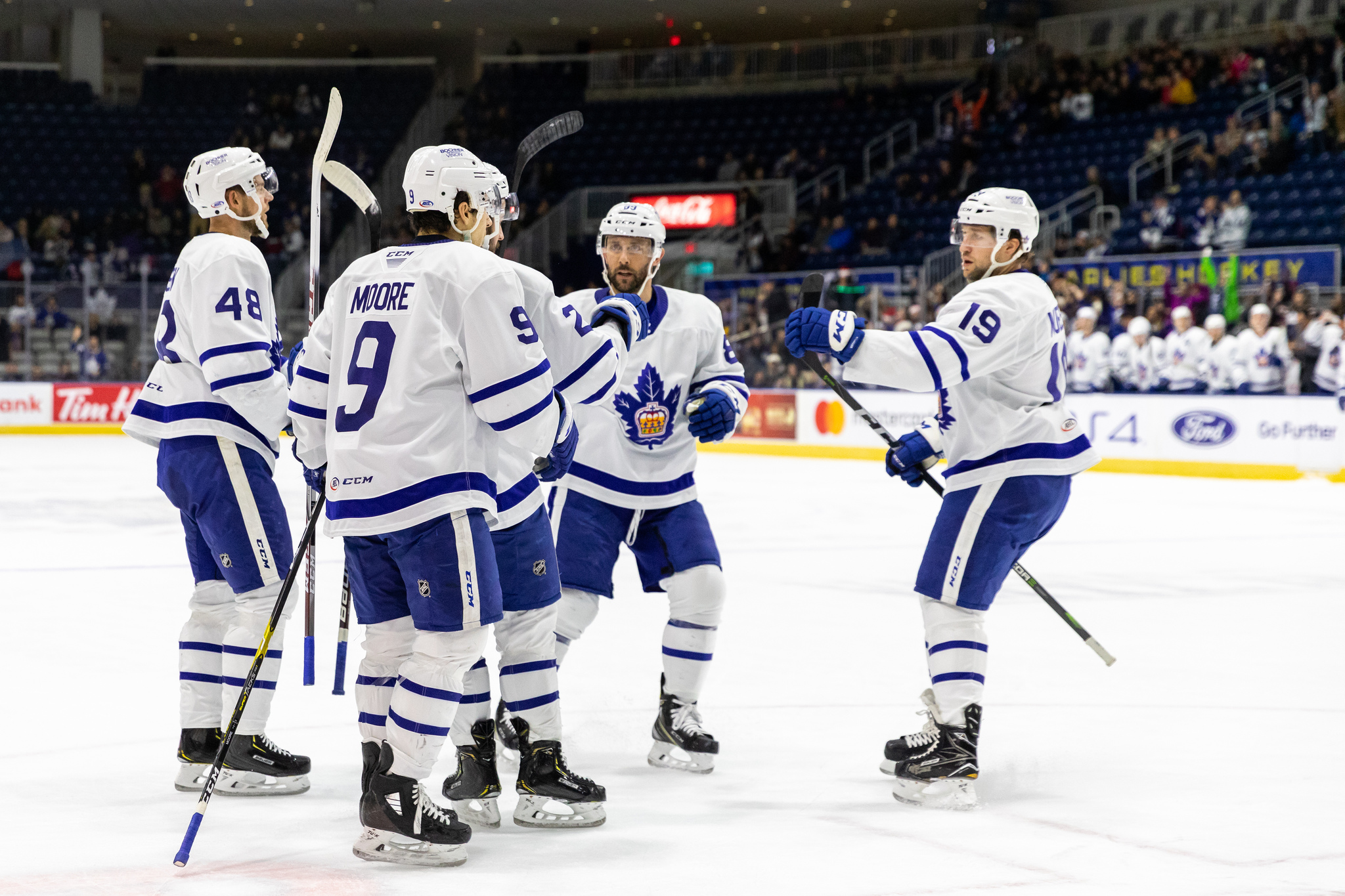The Toronto Marlies passed the midway mark of the regular season with a pair of games against Rochester Americans last weekend.
A win and a loss by the same 5-1 scoreline perfectly encapsulated the Marlies‘ inconsistent campaign so far. A 19-15-5 record leaves them embroiled in a battle for a playoff berth as the fourth-seeded team in the North Division at the moment.
The glass half full view on it is that the Marlies have not endured a losing month to date despite an inability to keep the puck out of their net (3.58 GAA) while frequently relying on their offense to bail them out (fourth-highest scoring team with 138 goals).
The reigning Calder Cup Champions were 4-4-1 through October after losing four straight games. November’s 4-3-3 record included six games decided in overtime and a notable 8-2 victory against Belleville.
The Marlies‘ hit and miss form was again the story in December: A record of 7-6-1 included suffering heavy losses to Syracuse (8-1), Providence (5-0) and Rochester (5-1), along with a pair of shutout victories against Belleville and Laval.
The Marlies are currently 4-2-0 through January, but they head on the road for the rest of the month, including two visits with the league-leading Charlotte Checkers. That might not be such a bad thing, though, as Toronto’s road form has been significantly better than what they’ve shown on home ice. The Marlies are 9-10-2 at Coca Coliseum and have allowed 75 goals in the process (3.6 per game). On the road, it’s been almost like a different hockey club altogether — the Marlies sport a 10-5-3 record with a +19 goal differential away from home.
It’s the record against North Division opponents (currently 14-12-5) that will ultimately determine whether or not Toronto makes the playoffs at the end of the season.
| North Division Opponent | 2018-19 Season Series |
|---|---|
| Rochester | 1-2-1 |
| Syracuse | 2-1-0 |
| Utica | 2-2-0 |
| Cleveland | 2-1-2 |
| Binghamton | 3-2-0 |
| Laval | 2-2-1 |
| Belleville | 2-2-1 |
With six of the next eight games scheduled against divisional rivals, the Marlies have to start adding to the win column, with just ten points separating first from eighth in the North Division at the moment.
As good as the Marlies power play has been (ranked fourth at 22.5%) the penalty kill remains of significant concern, currently ranked 30th overall in the league at 76.3%. It’s a good thing the Marlies have only been shorthanded on 160 occasions (second fewest in the Eastern Conference).
Goaltending has without doubt been Toronto’s weakest link, hindered by injuries and a lack of depth. It was never going to be plain sailing after the organization lost both Curtis McElhinney and Curtis Pickard to waivers, but they could not have anticipated veteran replacement Jeff Glass performing so miserably during his short tenure with the Marlies. Kasimir Kaskisuo was injured early in the campaign early in the season and hasn’t looked confident since his return, while both Newfoundland goaltenders (Eamon McAdam and Michael Garteig) have been drafted in with varying success.
The hope moving forward is that tried-and-tested netminder Michael Hutchinson can help improve on the team’s overall .876 save percentage while providing a steadying presence in the crease.
Other additions to the Marlies ranks since October include defensemen Frank Corrado, Kristians Rubins (currently with Newfoundland), Steve Oleksy (NHL trade) and forwards Sam Gagner (loan), Tom Sestito (PTO, although unlikely to feature), Michael Carcone (NHL trade), and Gabriel Gagne (NHL trade).
Subtractions include Adam Cracknell, Jeff Glass, Morgan Klimchuk, Andrew Nielsen, Ryan Sproul, and Kyle Cumiskey.
Player Grades
A
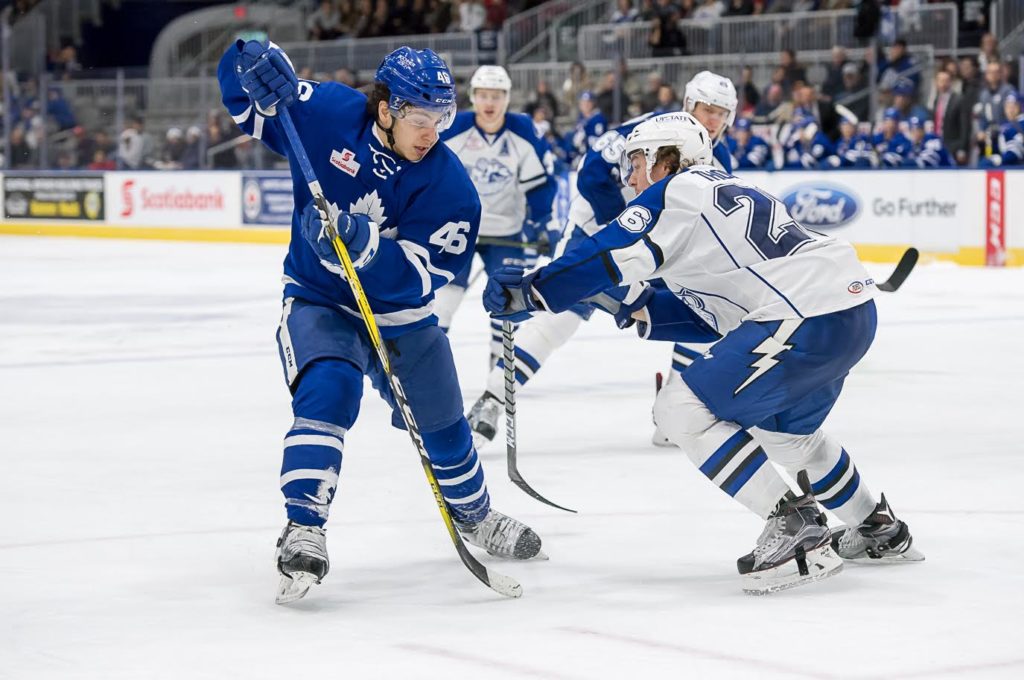
Chris Mueller (37 GP, 19g-20a-39pts)
Mueller has been Toronto’s talisman, leading the team in points, power play goals (10), power play points (20), game-winning goals (five including two in overtime), and sitting tied for the lead in goals (19). The veteran forward passed the 500 AHL career point mark this season and is on track to record career season highs in all categories. He has proven the most consistent forward on the team and Sheldon Keefe has leaned on the centerman heavily in key situations.
Trevor Moore (30 GF, 19g-7a-26pts)
Moore has proven his second half of the 2017-18 campaign was no fluke by establishing himself as the next Marlies’ player to graduate. Tied for fourth in Marlies scoring despite having featured in just 30 games, all but two of Moore’s 26 points are primary markers, and he will deservedly represent the team at the AHL All-Star weekend. The left winger leads the team in ES goals (11) and is tied with Chris Mueller for the overall lead in goals (19). Moore has featured on both special teams, taken his all-around game at both ends of the ice to a new level, and there simply isn’t anyone on the team who works harder than the 23-year-old winger.
Calle Rosen (36 GP, 4g-22a-26pts)
Rosen was no doubt disappointed to begin the season in the AHL, but he’s easily been Toronto’s most reliable and consistent performer on the blue line. He’s been carrying the load on the top line, helping Timothy Liljegren make the transition from limited minutes to the top defensive pairing while also providing the Marlies with some much-needed offensive output from the back-end. The Swedish blue liner has already surpassed last season’s point tally (22) and is ranked sixth among all AHL defensemen in that category. On the Marlies, Rosen is ranked fourth in even-strength points (3-14-17). His power play time was curtailed to begin the season, but Rosen has picked up the slack in that department of late with some key absences from the lineup. A regular on the penalty kill since day one, Rosen has certainly shown the organization enough to tie him up to a new two-year contract, and a continuation of his form through the second half of the year makes him a strong contender to make the Leafs next year.
A –
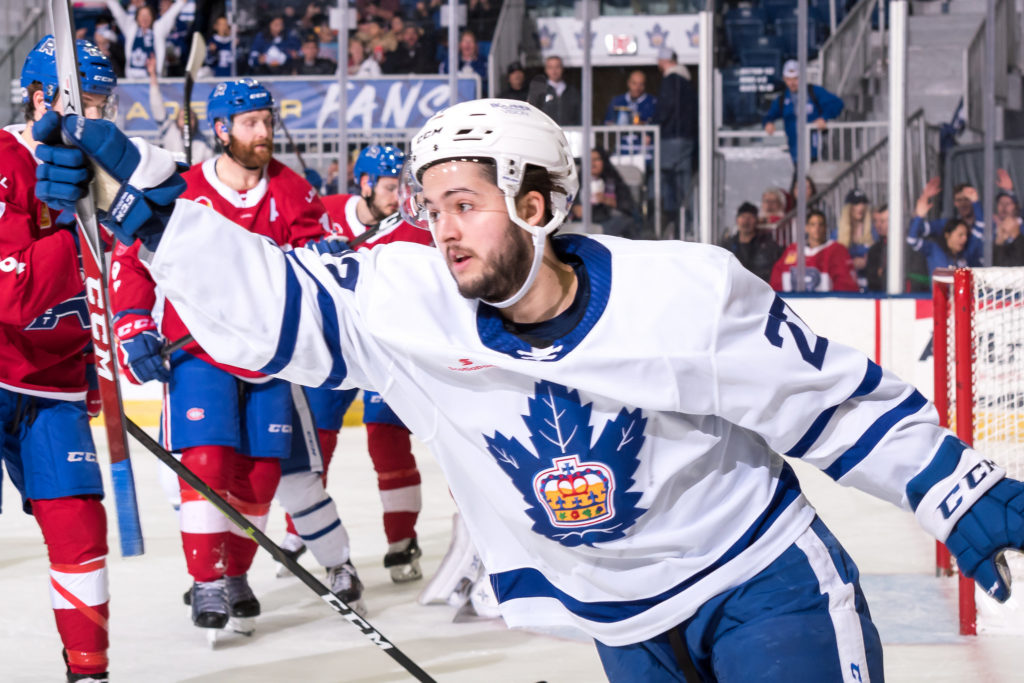
Timothy Liljegren (19 GP, 2g-6a-8pts)
I toyed with awarding Liljegren a B+, but after a shaky start, he was handling the extra responsibilities handed to him with aplomb. It’s a huge transition going from sheltered minutes to top pairing responsibilities. Alongside Calle Rosen, the pair were forming an excellent partnership prior to a high-ankle sprain injury that could not have come at a worse time for the young Swedish defenseman, denying him a trip to the World Juniors and robbing him of a full season’s development with the Maple Leafs desperately in need of help on the right side.
Jeremy Bracco (38 GP, 8g-29a-37pts)
Afforded the opportunity to play on the top line alongside Chris Mueller and Dmytro Timashov (primarily), the right winger has prospered after a somewhat sluggish beginning to the year (two points in nine games). Bracco leads Toronto in even-strength points (20) and total assists (29, of which 22 are primary), with his scoring mostly accumulated in batches (including five games of three-plus points). Primarily a set-up guy, Bracco does need to work on his pass-first predictability as opponents are dialing into his tendencies. At times, he’s beginning to heed the words of the coaching staff by driving to the net and getting on the inside of opponents. There’s also still work to do on the two-way aspect of his game, but Bracco has certainly come a long way since sitting out as a healthy scratch in the playoffs last Spring.
B+
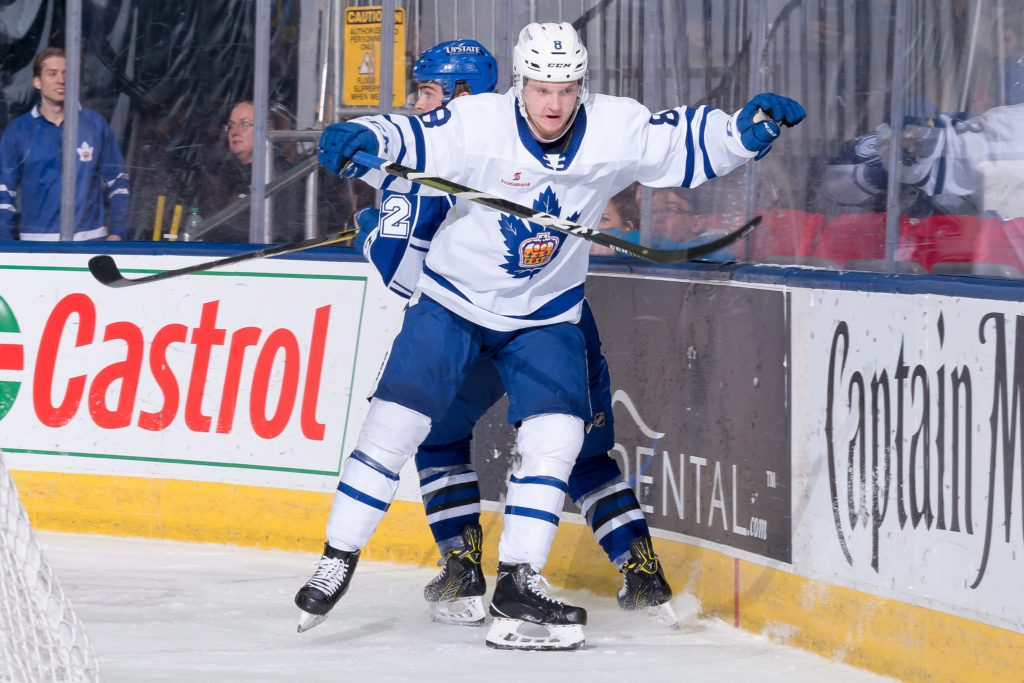
Vincent LoVerde (39 GP, 1g-6a-7pts)
Vincent LoVerde might well be a career AHL defenseman that is highly unlikely to step up to the next level at this stage, but the Marlies have been fortunate to count the veteran stalwart among their ranks this season. With the defense core whittled down to its bare bones, LoVerde has carried the bulk of the load on the right side. He began the year as one half of a promising partnership with Andreas Borgman, but he was soon tasked with mentoring Rasmus Sandin, who certainly flourished alongside the wily veteran before leaving for the World Juniors. Tasked with a larger role of late since Liljegren’s injury, the Chicago native has remained a reliable presence and even stepped in and did the job in a somewhat unnatural role on the power play.
Andreas Borgman (26GP, 3g-10a-13pts)
A concussion has cut short a promising season for Borgman, who had been hitting his stride after a rough beginning to the year. The Swedish defenseman has had a plethora of partners this year, but he looked at his best on a very solid second pairing alongside LoVerde. Borgman’s point production is slightly above last year’s (nine points in 25 games) in the AHL, with 11 primary markers and 12 of his 13 points accrued at even strength.
Rasmus Sandin (18 GP, 5g-5a-10pts)
Sandin wasn’t even expected to make the step up to the American League this season, but the decision is proving to be the right one. The 18-year-old defenseman flourished leading up to the World Juniors. While he’s been eased in with lighter assignments the same way Timothy Liljegren was during his rookie year, Sandin’s decision-making, poise and confidence in possession, and his strength in one-on-one battles have been standout traits for a teenager in the AHL. Sheldon Keefe was even confident enough to trust Sandin with time on the power play, where three of Sandin’s five goals have been scored. He doesn’t own a particularly hard shot at this stage, but he has a knack for getting the puck through mazes of traffic. Injured during the World Juniors, Sandin isn’t expected to return to game action until February. I’ve marked the rookie up a grade simply because being a teenage defenseman in the AHL and not looking out of place is no mean feat.
B

Pierre Engvall (35 GP 9g-6a-15pts)
Engvall is a tough player to assess because his point totals aren’t necessarily lining up with his play. Essentially cemented on the fourth line for the majority of the season, Engvall has only just been rewarded with top-six opportunity thanks to Dmytro Timashov’s inability to produce. He’s third on the Marlies in even-strength goals (eight) and has found the net twice in three games since his promotion.
Carl Grundstrom (37 GP, 11g-15a-26pts)
When assessing Grundstrom, we need to take a step back and remember this is his AHL rookie season. The Swedish winger was turning heads with 15 points in as many games to begin the year, but he has cooled off since. He recently broke an eight-game goalless slump during which he recorded just two assists and six shots on goal. Peaks and troughs are to be expected during a rookie season, and it’s highly encouraging that 19 of his points have been accrued at even strength, with 16 of those being primary markers. Grundstrom hasn‘t enjoyed the luxury of regular linemates, but there have been promising signs of life alongside Josh Jooris and Sam Gagner in the last three games, with Grundstrom putting up two goals and an assist.
Josh Jooris (39 GP, 6g-5a-11pts)
I’m not certain Toronto had Jooris pegged as their second line center to begin the season, but with Adam Brooks missing time and Adam Cracknell moved out, that’s where the Burlington native has slotted in. Solid more than spectacular, Jooris has certainly looked more of a threat offensively since joining a line with Sam Gagner and Carl Grundstrom.
A fixture on the penalty kill, Jooris has two shorthanded goals to his name this season.
Mason Marchment (34GP, 10g-11a-21pts)
Mason Marchment has been good without really taking off as of yet following a successful 2018 playoff campaign. He was injured to begin the year but quickly hit his stride, producing 14 points in 15 games. It’s been a struggle since then, with just two goals and five assists in the subsequent 19 games, but being reunited with his linemates from last year (Marchment-Brooks-Moore) might be the spark the left winger needs going forward.
Adam Brooks (26 GP, 7g-8a-15pts)
Brooks missed the beginning of the season with an upper-body injury and then suffered a heart scare in November, which thankfully turned out to be nothing serious. The second-year centerman is yet to find his groove with the personal and team setbacks this season, but a strong second half looks like a strong possibility with full fitness and the return of the ‘kid line’ (Marchment-Brooks-Moore) that was dominant during the Marlies’ championship run.
Frank Corrado (27 GP, 1g-3a-4pts)
Frank Corrado has been a nice story working his way back from a particularly nasty knee injury. He’s supplied depth to the right side of Toronto’s defense, adding a stability that Jordan Subban fails to provide. Having to play a little further up the lineup than Sheldon Keefe might’ve intended while paired with less experienced partners, we might see a stronger second half to the season for Corrado once the Marlies get their players back from injury.
Eamon McAdam (17 GP, 9-4-3, .898 SV%, 2.81 GAA, 1 SO)
Thrust into the spotlight as the Marlies’ number one goaltender, Eamon McAdam has performed admirably in the circumstances. There have been signs of improvement in his game, as he’s certainly looked more confident in his last two starts while challenging shooters more aggressively at the top of his crease. Whether the Pennsylvania native is anything more than a .900 goaltender at the AHL level remains to be seen, but he more than anyone has given the Marlies a chance to put some wins on the board.
B-

Dmytro Timashov (36 GP, 5g-20a-25pts)
Timashov is proving to be one of Toronto’s most frustrating prospects. With the clock starting to tick on him as far as the organization’s appetite to develop and afford the 22-year-old more opportunities, he needs to have a strong second half to the season. Sheldon Keefe resorted to benching Timashov after he took a batch of penalties in addition to his penchant for disappearing for large spells of games. Recently demoted to the fourth line, the left winger showed some promising signs alongside Colin Greening and Michael Carcone with an assist in each of his last three games, but a more consistent second half is going to be critical to Timashov’s future with the organization.
Michael Carcone (14 GP, 5g-3a-8pts)
Carcone likely would have been awarded a higher grade if not for his selfish cross-check to a Rochester player’s head during a TV timeout recently. He’s avoided supplementary discipline from the league, but it cost the Marlies the chance of getting points out of the game and Sheldon Keefe took a dim view of the incident. Outside of that, he’s put together a promising 14-game stint since arriving in Toronto. He undoubtedly requires some work defensively, but his offensive skills and skating ability are clear to see. He did recently sustain a concussion in the game he was kicked out of versus Rochester.
Colin Greening (39 GP, 3g-6a-9pts)
Colin Greening has been one of just three ever-presents in the Marlies lineup this season. As is his way, he has been a relatively steady performer during a season of highs and lows. The veteran forward has found himself at center more often than not, and unsurprisingly, he hasn’t produced much in the way of offense when paired with the likes of Griffen Molino, Emerson Clark, and Morgan Klimchuk. Dmytro Timashov and Michael Carcone flanking Greening looked like a promising line, and perhaps the 32-year-old can help the former find his game in the second half of the season.
C
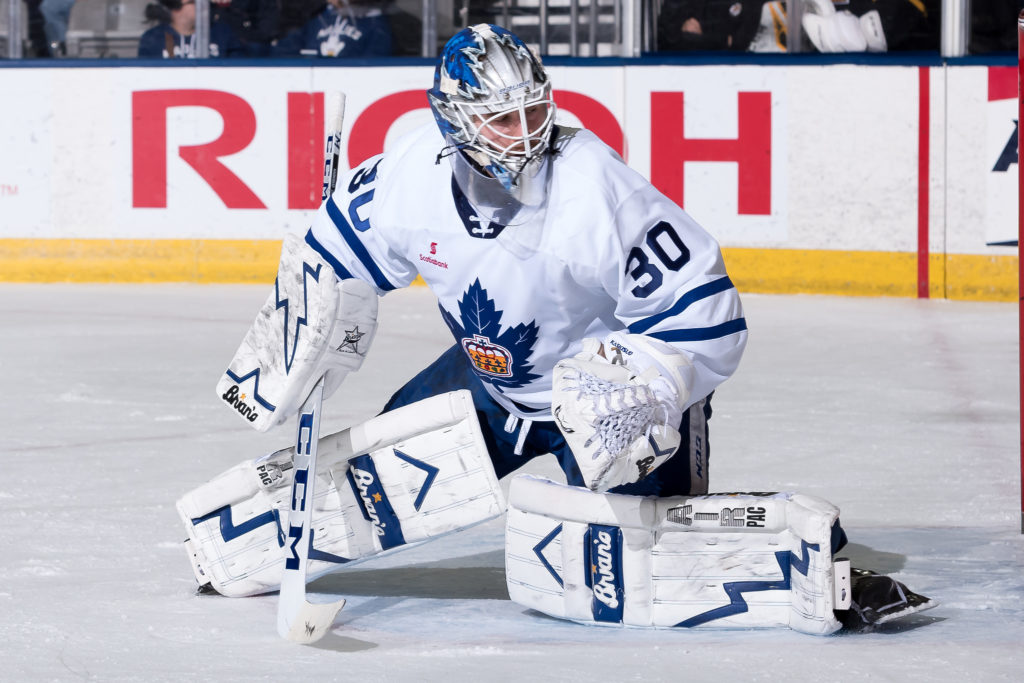
Jordan Subban (25 GP, 2g-8a-10pts)
The former Vancouver prospect has shown few signs of improvement in his defensive game since arriving in Toronto. Benched in mid-November, Subban got back into the lineup due to the injury situations and even found himself playing some right wing when Toronto was critically short on bodies. He’s been at his most effective when simplifying his game in the defensive zone and looking for safer outlet passes. He still loses far too many one-on-one battles and his prowess on the power play hasn’t come to fruition with just a pair of goals scored there early in the year.
Kasimir Kaskisuo (14 GP, 5-6-1, .867 SV%, 3.85 GAA, 1 SO)
The signs were promising for Kasimir Kaskisuo to have a breakout year with the Marlies’ #1 job for the taking. A career .929 save percentage in 38 AHL starts heading into this campaign, it hasn’t worked out this season for the Finnish goaltender, who appeared to lack any sort of confidence in his game. Perhaps it’s the change in goaltending coach (Jon Elkin replacing Piero Greco), but whatever the case, he’s a shell of the player the Marlies thought they were trusting with the starting job.
Griffen Molino (16 GP, 1g-1a-2pts)
Mostly deployed for fourth-line duties, Griffen Molino has struggled to make any kind of impact in his second year as a professional. Now reassigned to Newfoundland, the hope is the 21-year-old can develop in the ECHL with greater ice-time and opportunities.
Ungraded
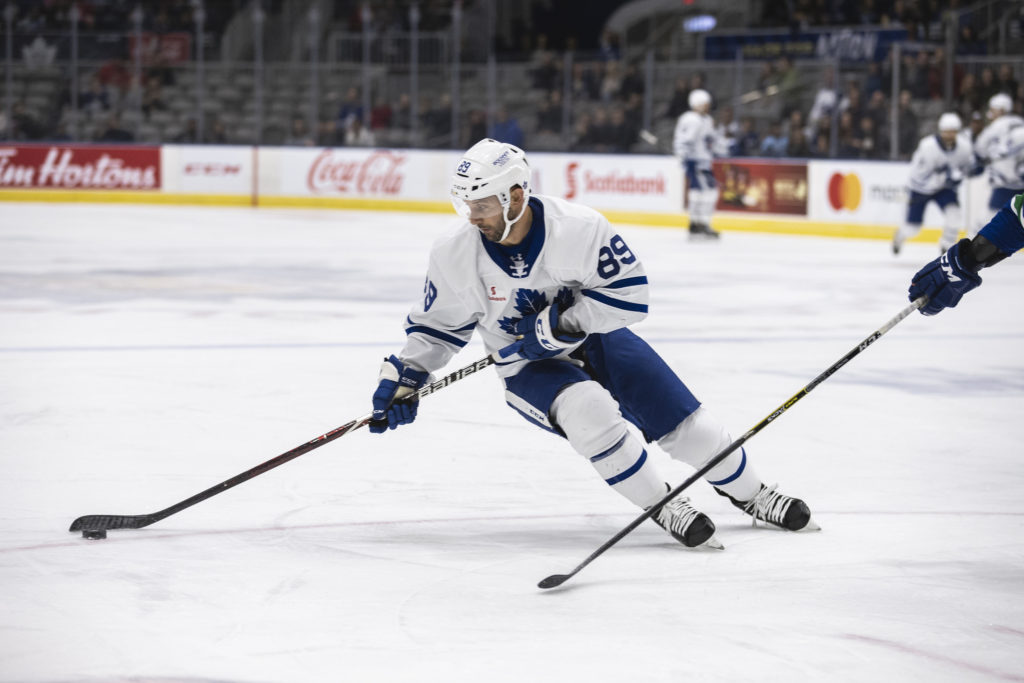
Sam Gagner (32 GP, 9g-22a-31pts)
Sam Gagner isn’t afforded a grade because he’s not Toronto property, but I’d be remiss not to mention his contributions to the team. Despite finding himself in a less-than-ideal situation at this point in his career, Gagner has knuckled down and been a consummate professional in his time with the Marlies. Third in team scoring despite having been recalled once by Vancouver, the London native has been asked to play both center and wing during his loan stint and he’s proven a keg cog in the Marlies’ power play success (third in goals and points).
Stefan Leblanc (11 GP 0g-4a-4pts), Sam Jardine (19GP, 0g-4a-4pts)
I’ve linked these two together because they’ve both been excellent for Newfoundland this season and have been switching assignments on the second and third pairing on the left side for Toronto. A fairer judgment on both can be made if either sticks around when the Marlies’ blue line returns to full strength.























